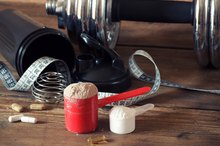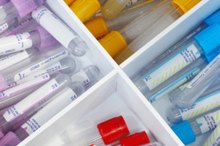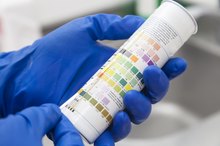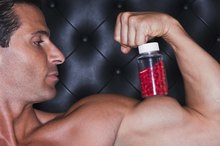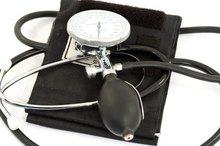What does fact checked mean?
At Healthfully, we strive to deliver objective content that is accurate and up-to-date. Our team periodically reviews articles in order to ensure content quality. The sources cited below consist of evidence from peer-reviewed journals, prominent medical organizations, academic associations, and government data.
The information contained on this site is for informational purposes only, and should not be used as a substitute for the advice of a professional health care provider. Please check with the appropriate physician regarding health questions and concerns. Although we strive to deliver accurate and up-to-date information, no guarantee to that effect is made.
How Does Creatine Affect the Kidneys?
Creatine is a dietary supplement that is often used to improve athletic performance. Excessive use of creatine can strain the kidneys and cause kidney damage. Individuals should follow proper dosing recommendations for creatine and consult a physician prior to taking supplements. Individuals who currently take creatine and have kidney problems should discontinue use of creatine to prevent further kidney damage.
If you are experiencing serious medical symptoms, seek emergency treatment immediately.
Creatine
Creatine is an amino acid that is synthesized in the kidneys and liver and supports muscle growth and contraction, according to Peace Health. Creatine is naturally available in fish and meat and is also marketed to athletes as a performance-enhancing supplement. According to the Mayo Clinic, the most popular creatine supplement is creatine monohydrate. Prolonged use or high doses of creatine may contribute to kidney damage.
- Creatine is an amino acid that is synthesized in the kidneys and liver and supports muscle growth and contraction, according to Peace Health.
- Creatine is naturally available in fish and meat and is also marketed to athletes as a performance-enhancing supplement.
Kidneys and Creatinine
Is Creatine a Safe Supplement for Teenagers?
Learn More
Kidneys remove waste from the body, help form red blood cells and help regulate blood pressure. Creatinine is a chemical waste product of creatine 2. It is usually filtered out through the kidneys and excreted in the urine. High levels of creatinine in the blood can be caused by high doses of creatine and may be a sign of kidney damage and the inability of the kidneys to filter out creatinine 2.
MedlinePlus says kidney problems that are associated with high creatinine levels include acute tubular necrosis, diabetic nephropathy, glomerulonephritis or pyelonephritis, all of which can lead to chronic kidney disease (CKD) or kidney failure 2. CKD and kidney failure can result in seizures, coma and, ultimately, death. Individuals with either condition may need dialysis, a regular treatment that cleans the blood, or a kidney transplant.
- Kidneys remove waste from the body, help form red blood cells and help regulate blood pressure.
- MedlinePlus says kidney problems that are associated with high creatinine levels include acute tubular necrosis, diabetic nephropathy, glomerulonephritis or pyelonephritis, all of which can lead to chronic kidney disease (CKD) or kidney failure 2.
Lab Values
According to the Mayo Clinic, normal blood creatinine is 0.6 to 1.2 mg/dL 2. Men usually have higher creatinine levels than women because creatinine increases with muscle mass 2. High creatinine can be caused by dehydration, certain medications and creatine supplements 2.
Dosing
Whey Protein Products Containing Creatine Side Effects
Learn More
The University of Maryland Medical Center says the risk of kidney damage is greater when high doses of creatine supplements are taken 3. The Mayo Clinic does not advise taking more creatine than is recommended by manufacturers. A normal loading dose for an athlete prior to an athletic event is 5g, four times a day for a week. A maintenance dose for athletes is 2 to 5g per day.
- The University of Maryland Medical Center says the risk of kidney damage is greater when high doses of creatine supplements are taken 3.
- A normal loading dose for an athlete prior to an athletic event is 5g, four times a day for a week.
Warnings and Considerations
According to MedlinePlus, possible side effects of creatine supplements include:
- upset stomach
- loss of appetite
- diarrhea
- nausea
- muscle cramps
- heat intolerance
- fever
- dehydration
- reduced blood volume
- electrolyte imbalances
- increased thirst
- headache
- anxiety
- irritability
- aggression
- nervousness
- sleepiness
- depression
- abnormal heart rhythm
- fainting or dizziness
- blood clots in the legs
- seizure
- swollen limbs 2
Related Articles
References
- MayoClinic.com: Creatinine test
- MedlinePlus: Creatinine
- University of Maryland Medical Center: Creatine
- Cooper Institute: Creatine Supplements: Friend or Foe for Exercise Performance?
- Kreider, R. B. International Society of Sports Nutrition position stand: safety and efficacy of creatine in exercise, sport, and medicine. Journal of International Society of Sports Nutrition. 2017; 14: 18.
- MedlinePlus. Creatine.
Resources
Writer Bio
Bethany Fong is a registered dietitian and chef from Honolulu. She has produced a variety of health education materials and worked in wellness industries such as clinical dietetics, food service management and public health.

